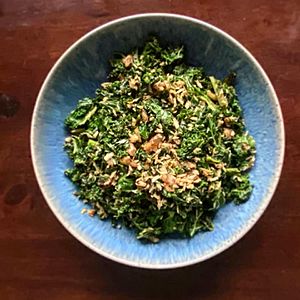Mallung facts for kids
 |
|
| Alternative names | Mallum, Mallem |
|---|---|
| Course | Side dish |
| Place of origin | Sri Lanka |
| Associated national cuisine | Sri Lankan cuisine |
| Main ingredients | Leafy greens, grated coconut |
| Ingredients generally used | Onion, chili, spices, Maldive fish |
Mallung or mallum is a popular Sri Lankan dish. It is made from shredded leafy green vegetables. These greens are lightly cooked or sautéed with fresh coconut, spices, and chili.
Mallung is a very common side dish in Sri Lanka. People eat it with almost every meal. It helps locals get important vitamins in their diet. The word 'mallung' or 'mallum' means 'wilted'. This describes how the greens look after cooking.
What is Mallung Made Of?
The main part of mallung is a leafy green vegetable. It is cut into small pieces. Then, it is mixed with other ingredients to make it taste great.
Common Ingredients
Many different plants can be used to make mallung. Some traditional ones include cassia, passion fruit leaves, watercress, and water spinach. In countries like the United States or Europe, people might use spinach, cabbage, chard, or kale instead.
The greens are usually mixed with:
- Chopped green chilies
- Chopped shallots (a type of onion)
- Chopped curry leaves
- Crushed garlic
- Shredded coconut
- Spices like turmeric, salt, and pepper
- Powdered Maldive fish (dried tuna)
- Lime juice
Types of Greens Used
In Sri Lanka, many different types of greens are used. Some are wild, and some are known for their health benefits. Most often, the leaves of native plants are chosen.
Some very popular greens for mallung include:
- Gotukola (Centella asiatica)
- Kankun (Ipomoea aquatica)
- Kathurumurunga (Sesbania grandiflora)
- Mukunuwenna (Alternanthera sessilis)
Other herbal leaves like aguna (Dregea volubilis), Cheilocostus speciosus, and passionfruit leaves are also used.

